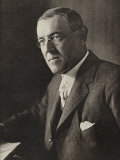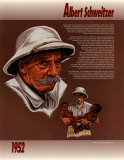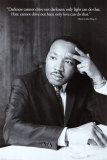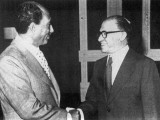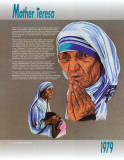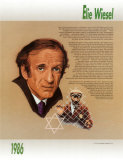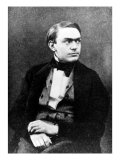|
|
|
|
|
|
|
PEACE & JUSTICE CALENDARS
|
|
|
|
|
|
|
|
|
|
|
|
|
|
|
|
|
|
|
|
 |
|
|
|
Nobel Peace Prize Winners Educational Posters, pg 1/2
for classrooms and homeschoolers.
|
Peace Education | peace & justice activists list | NOBEL PEACE PRIZE WINNERS 1 | 2 < social studies
|
|
 Nobel Peace Prize Winners poster series Woodrow Wilson, Albert Schweitzer, Martin Luther King, Jr., Henry Kissinger, Sadat & Begin, Mother Teresa, Desmond Tutu, Elie Wiesel and Mikhail Gorbachev; see page 2 for more such as Elihu Root, Charles Dawes, Frank Kellogg, and Ralph Bunche. Nobel Peace Prize Winners poster series Woodrow Wilson, Albert Schweitzer, Martin Luther King, Jr., Henry Kissinger, Sadat & Begin, Mother Teresa, Desmond Tutu, Elie Wiesel and Mikhail Gorbachev; see page 2 for more such as Elihu Root, Charles Dawes, Frank Kellogg, and Ralph Bunche.
Alfred Nobel, Swedish chemist and industrialist, established the Nobel Prizes for physical science, chemistry, medical science, literature and peace in 1895 after reading the premature announcement of his death in 1888 that said, “Dr. Alfred Nobel, who became rich by finding ways to kill more people faster than ever before, died yesterday.”
|
|
|
|
Nobel Peace Prize Winners, 1919 -
Woodrow Wilson
b. 12-28-1856; Staunton, VA
Woodrow Wilson is usually considered to be one of our nation's three or four most successful presidents. He was without a doubt one of the the most remarkable figures in American history. Although he led the nation through a terrible war, he is best remembered as a man who devoted his life to making the world a more peaceful place for all humankind.
Thomas Woodrow Wilson was born around midnight on December 28, 1956. His mother named him after her father, but Wilson dropped the name Thomas after he graduated college. From very early on, religion and education were stressed in the Wilson household. Young Woodrow's earliest memories were of the election of Abraham Lincoln and the outbreak of the Civil War. The war forced many schools in the South to close, so Woodrow's father had to teach him at home. And every evening the Wilson's would gather to read the Bible together. In 1875, Wilson enrolled at the College of New Jersey, now called Princeton University. After graduation, Wilson went on to work as a lawyer, teacher, and politician. He served as the president of Princeton and in 1910 was elected governor of New Jersey. Wilson's strong belief in fairness, democracy, and clean government soon made him famous across the nation,and it helped him get elected President in 1912.
As President, Wilson tried desparately to keep the United States out of World War One. In fact, he was re-elected in 1916 with the campaign slogan: “Wilson – He Kept Us Out of War.” But when Germany began attacking U.S. ships, Wilson was left with no choice but to enter the war. Wilson proved to be a great wartime leader, and when the war ended he set up a plan for lasting peace. But one of the key points of his plan – the creation of an international peacekeeping organization called the League of Nations – failed to gain support. Nevertheless, Wilson's efforts won him the Nobel Peace Prize in 1919. About thirty years later, Wilson's dream came true with the creation of the United Nations. Sadly, President Wilson suffered a stroke later in 1919 and lived as an invalid until his death in 1924.
• more Woodrow Wilson posters
|
|
|
|
Albert Schweitzer
b. 1-14-1875; Alsace, Germany
d. 9-4-1965
Few people have ever given as much of themselves to others as Dr. Albert Schweitzer. Like Mother Teresa, Dr. Schweitzer combined a deep religious faith with a strong desire to help the less fortunate people of the world. His work as a missionary and physician in Africa saved thousands of lives. And his philosophy of 'reverence for life' made him one of the most loved and admired men of the century.
Albert Schweitzer was born in 1875 in a region known as Alsace. At the time, Alsace was part of Germany. But after World War One, it became a part of France. Albert's father was a minister in a church that served both Lutherans and Catholics. This may help explain Albert's interest in religion, and his remarkable ability to understand and accept all kinds of people. As a young boy, Albert played the organ in the church, and much of this early education was in music. But in Strasbourg University, he studied philosophy and theology – that is, the study of religion. In 1906, Schweitzer left Strasbourg to enter medical school. There, he met and married Helene Bresdau. In 1913, the Schweitzers left set sail for Africa, where they built a hospital along the Ogowe River in Gabon. Dr. Schweitzer had so little money that his first office was chicken coop! But over the years, the hospital grew in size and became more modern. Dr. Schweitzer raised money for the hospital by selling books and record albums, and by giving concerts and lectures.
In his later years, Dr. Schweitzer continued to help the poor. And he took up the cause of world peace – speaking out against nuclear wapons. In 1952, he was awarded the Nobel Peace Prize for his many contributions to the world. Albert Schweiter died in 1965 and was buried near his beloved hospital in Africa.
• Albert Schweitzer posters
• Bach posters
• vegetable posters
|
|
|
|
Martin Luther King Jr.
b. 1-15-1929; Atlanta, GA
d. 4-4-1968; Memphis, TN
Martin Luther King, Jr. was a man who symbolized peace, nonviolence, and love ofr all human beings. Yet during his short life, he was often a victim of hatred and violence. And it was an act of terrible violence that finally ended his life in 1968. Today, Martin Luther King is one of only three Americans whose birthdays are celebrated as national holidays. And the other two were U.S. Presidents.
Martin Luther King was born in Atlanta, Georgia, in 1929. His father was a minister at a local Baptist church, and Martin grew up surrounded by religion and listening to his father's powerful voice. Later in life, he imitated this speaking style in his emotional speeches. Martin was such a good student that he was able to skip the 9th and 12th grades. He entered Morehouse College in Atlanta at the age of 15 and began studying to be a minister. After his schooling, King got a job as pastor of the Dexter Avenue Baptist Church in Montgomery, Alabama. In 1958, a black woman in Montgomery named Rosa Parks was arrested for refusing to give up her bus seat to a white passenger. Martin Luther King helped organize and lead a boycott of the Montgomery buses. This marked the beginning of Reverend King's long fight against prejudice and discrimination.
Martin Luther King believed that the nonviolent tactics of leaders like India's Mohandas Gandhi were the best way to work for change. He lead many protest marches and demostrations calling for equal rights for blacks. In 1963, he lead a huge march on Washington, D.C. that drew more than 200,000 people. There, he delivered his now-famous “I Have A Dream” speech. In 1964, Rev. King was awared the Nobel Peace Prize for his work to gain equality for black and his efforts to help the poor. In 1968, while in Memphis to help striking workers, Martin Luther King was assassinated by a white man named James Earl Ray. On his grave are words he spoke at the 1963 March on Washington: “Free at last, free at last, thank God Almighty, I'm free at last.”
• more Martin Luther King, Jr. posters
• Black History posters
|
|
|
|
|
|
|
Anwar Sadat & Menachem Begin -1978
Poster Text: Anwar Sadat and Menachem Begin shared the 1978 Nobel Peace Prize for their efforts to solve one of the oldest and most difficult problems in the world: the conflict between Arabs and Jews in the Middle East. Tensions between these groups grew worse when at separate state for the Jewish people, the nation of Israel, was created in 1948 from the Arab state of Palestine. The Arabs immediately attacked the new nation of Israel. And Israel and the Arab nations, including Egypt, became bitter enemies. In the years that followed, Israelis and Arabs fought several brief but violent wars. The Arab countries were determined to destroy Israel, and the Israelis fought back aggressively.
Anwar Sadat was on Egyptian military office who took part in efforts to overthrow hsi nations government in the 1940s. Later he became Egypt's Vice President under Egyptian President Gamal Abdel Nasser. When Mr. Nasser died in 1970, Mr. Sadat took over. He called for Israel to return land it had taken from Egypt in a 1967 war. But in 1977, President Sadat began discussions with Israeli leader Menachem Begin about ways to end the conflict between their two nations.
Mr. Begin was one of many people who fought during the 1930s and 1940s for the creation of Israel. After Israel was formed, Mr. Begin served in the Israeli Parliament which is called the Knesset. He became the Prime Minister of Israel in 1977.
Together with U.S. President Jimmy Carter, Mr. Sadat and Mr. Begin met for peace talks. The talks resulted in an agreement that called for Israel to withdraw from the Sinai Peninsula and the Gaza Strip. It als called for a formal peace treaty between Israel and Egypt. And it said Israel must take steps to give Palestinian Arabs in the West region their own government. The agreement, which became known as the Camp David Accords, won Mr. Sadat and Mr. Begin the Nobel Peace Prize.
Sadly President Sadat was killed in 1981 by Arabs opposed to peace with Israel. And after Mr. Begin resigned as Prime Minister in 1983, he took little part in Israeli politics. He died in 1992.
Even though some parts of the Egyptian-Israeli peace treaty have not been fulfilled, the agreement was an important first step toward peace in the Middle East.
• Anwar Sadat & Menachem Begin at Amazon.com
|
|
|
|
Nobel Peace Prize Winners, 1979 -
Mother Teresa
b. 8-27-1910; Skopje, Macedonia
Mother Teresa, a Roman Catholic nun who devoted her life to caring for others, was awarded the Nobel Peace prize in 1979. Her work with the poorest people of India made her one of the most beloved and honored figures in the world. But she always insisted that her greatest reward was her work. She once described herself as "a little pencil in the hand of God".
• more Mother Teresa posters
• India posters
|
|
|
|
Nobel Peace Prize Winners, 1984 -
Bishop Desmond Tutu
b. 1931; Klerksdorp, South Africa
Text from unavailable poster: Desmond Tutu was awarded the Nobel Peace Prize in 1984 for his work to end the system of apartheid, or racial separation, in South Africa. When is gave out he award, the Nobel committee said the prize should be seen as a way to recognize the courage of all black South Africans in their long struggle for freedom and equal rights.
Desmond Tutt was born in 1931 in the village of Klerksdorp in the Transvaal in South Africa. His father was a teacher in a mission school that Desmond attended. As a young boy, Desomnd's dream was to become a doctor. But his family could not afford to send him to medical school. Instead, he went to college and studied to be a teacher. At the age of 25, Desmond decided that he wanted to become a priest in the Anglican church. In 1960, he got his wish. Since then, Desmond Tutu has been appointed to more and more powerful positions in the Church. In 1975, he became the first black Anglican dean at Johannesburg, one of South Africa's lagest cities. In 1978, he was named the head of a group called the South African Council of Churches – a group with more than twelve million members.
For many years Bishop Tutu was one of the most important leaders of South Africa's anti-apartheid movement. Like Gandhi and Martin Luther King, Jr. – two leaders Bishop Tutu admires – he believes that change can be made through peaceful, nonviolent means. Bishop Tutu urged nations to use measure such as economic sanctions and other punishments to force and end to apartheid. And other many years of struggle, his efforts paid off. Gradually apartheid issues were removed. In 1994, the last apartheid barrier was lifted, and South Africa held its first election that was open to blacks as well as whites. The country's overwhelming black majority elected a black Prsident, Nelson Mandela. The new government formed a group called the Truth and Reconciliation Commission to investigate the crimes and atrocities that occurred under apartheid. Bishop Tutu was the chairman of the commission.
• Africa posters
• Bishop Desmond Tutu at Amazon.com
|
|
|
|
Nobel Peace Prize Winners, 1986 -
Elie Wiesel Poster
b. 9-30-1928; Sighet, Transylvania
Poster Text: Upon announcing that author, philosopher, and educator Elie Wiesel would receive the 1986 Nobel Peace Prize, the head of the Nobel committee said, “Elie Wiesel has emerged as one of the most important spiritual leaders and guides ... when violence, repression, and racism continue to characterize the world. His message is one of peace ... and human dignity.” Mr. Wiesel began spreading this message after he survived one of the most horrifying expereinces humans have ever had to face – life in a Nazi concentration camp. He lived through the Holocaust – the Nazis terrible campaign to exterminate the Jewish people.
Elie Wiesel was born in 1928 in Sighet, Romania. The Wiesels were a Jewish family with one son, Elie, and three daughters. Elie expected to spend his life in this quiet little town, studying religious texts and helping in his father's store. But World War Two and the Nazis shattered this dream. The Nazis overran Europe. They rounded up Jews and sent them to prison-like concentration camps. And in the spring of 1944, the Nazis reached Sighet. The Wiesels were among the Jews herded into trains bound for concentration camps in Poland. The Wiesels were sent to Auschwitz, one of the most famous Nazi death camps. More than a million people – mostly Jews – died in the gas chambers or from starvation, illness, and abuse at Auschwitz. When the Wiesels arrived there, they were stripped of their personal possessions, and Elie's mother and sister were killed. In his book, Night, Elie Wiesel described his memory of his arrival at the concentration camp: ‘Never shall I forget that night, the first night at the camp, which has turned my life into one long night.’ Elie and his father survived Auschwitz and were sent to another camp, called Buna, where they worked on slave labors. Only a few months before World War Two ended in 1945, Elie and his father were moved again to a camp called Buchenwald. Elie's father died at Buchenwald of disease and starvation.
After World War Two, Elie Wiesel moved to Paris, where he studied philosophy. He worked as a journalist, writing for Israeli, French, and American newspapers. In 1956, he moved to the United States, and he became an American citizen seven years later. Since then Elie Wiesel has spent his time teaching, writing, and lecturing. He continues to work for human rights everywhere, and he believes that speaking out against oppression will help prevent other holocausts.
• more Elie Wiesel
|
|
|
|
Mikhail Gorbachev
b. 3-2-1931; Russia
Poster Text: The decision to give the 1990 Nobel Peace Prize to Soviet President Michail Gorbachev was one of the most controversial in the history of the award. The members of the Nobel committee felt that Mr. Gorbachev was at least partly responsible for the dramatic changes in Eastern Europe in 1989. And they wanted to reward Mr. Gorbachev for his efforts to make his own nation more free and open. But in the months ofter the award was given many people criticized the choice. They pointed to Mr. Gorgachev's use of force against people struggling for independence in the Soviet republics of Lativia and Lituania. And they questioned whether the Soviet leader truly believed in democracy and freedom. As with Henry Kissinger, most people have strong feeling about Michail Gorbachev winning this great honor. But there is no doubt that in the 1980s, Mr. Gorbachev did more to change the world than any other leader.
Very little is known about Mikhail Gorbachev's past. But experts do know that he was born in southern Russian in 1931, and that his first job was driving a tractor. In 1950, he took the first important step in his career when he entered Moscow State University. Only the best students or those who know top officials get into this school. Mr. Gorbachev trained as a lawyer, but he decided to become an official of the Communist Party. In 1980, he became a full member of the Politburo – the top decision-making group in the Soviet government. At the age of 49, he was placed in charge of the country's agriculture. When Konstantin Chernenko died in 1985, Mr. Gorbachev took over as leader of the Soviet Union. His first task was to try to improve the nation's economy. But he was not very successful. In the early 1990s, Mr. Gorbachev was fighting to hold his nation together, and to make it as strong and wealthy as the nations of the West.
• Mikhail Gorbachev at Amazon.com
|
|
|
|
Alfred Nobel
b. 10-21-1833; Sweden
d. 12-10-1896; Italy
Chemist, engineer, innovator, and armaments manufacturer Alfred Nobel was the inventor of dynamite. He held 355 different patents and used his enormous fortune to institute the Nobel Prizes. The synthetic element nobelium (No, atomic number 102) was named after him.
• Alfred Nobel: Inventive Thinker
|
|
|
Peace poster index | 1 Picasso Peace Posters | 2 | 3 | NOBEL PEACE PRIZE WINNERS 1 | 2
previous page | top
|
|
I have searched the web for visual, text, and manipulative curriculum support materials - teaching posters, art prints, maps, charts, calendars, books and educational toys featuring famous people, places and events - to help teachers optimize their valuable time and budget.
Browsing the subject areas at NetPosterWorks.com is a learning experience where educators can plan context rich environments while comparing prices, special discounts, framing options and shipping from educational resources.
Thank you for starting your search for inspirational, motivational, and educational posters and learning materials at NetPosterWorks.com. If you need help please contact us.
|
|
|









